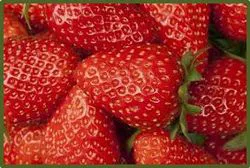 Strawberries are appreciated for their flavour and nutritional value. They are rich in bioactive compounds, such as phenols and anthocyanins, the latter are responsible of red colour fruit.
Strawberries are appreciated for their flavour and nutritional value. They are rich in bioactive compounds, such as phenols and anthocyanins, the latter are responsible of red colour fruit.Freshly harvested strawberries are very susceptible to mechanical damage, water loss, decay and physiological deterioration. For these reasons, strawberries are packaged into clamshell containers directly from the field and delivered to the supermarkets.
However, the postharvest decay is mainly due to yeast and mould growth.
Most of fresh produce processors use chlorine-based washing for the microbial decontamination, but in some European Countries, such as Germany, the Netherlands, Switzerland, and Belgium, the use of chlorine for washing fresh and fresh-cut produce is prohibited.
Irish scientists have evaluated the potential use of Atmospheric pressure Cold Plasma (ACP) for the microbial decontamination of strawberries inside a closed package.
Fig 1 - Schematic of the experimental set-up employed for ACP treatment of strawberries.
For the study, strawberries were treated with atmospheric pressure cold plasma (ACP), generated with 60 kV dielectric barrier discharge (DBD) pulsed at 50 Hz, across 40 mm electrode gap. Strawberries were exposed to indirect ACP treatment for 5 minutes and then stored for 24 h at 10 °C and 90% RH.
Microbial reductions on strawberry surface by indirect atmospheric cold plasma (ACP) treatment in air.
The voltage conditions have showed that plasma worked in the filamentary regime. The background microflora (aerobic mesophilic bacteria, yeast and mould) of strawberries treated with ACP for 5 minutes was reduced by 2 log 10 within 24 hrs after treatment, without significant impact on fruits with regard to respiration rate, colour and firmness. DBD system used for this study reached the desired effects with a power input of only 15-20 W, without increasing the temperature of treated fruits.
Source: Misra N.N., Patil S., Moiseev T., Bourke P., Mosnier J.P., Keener K.M., Cullen P.J., "In-package atmospheric pressure cold plasma treatment of strawberries", 2014, Journal of Food Engineering, Vol. 125, pagg. 131-138. Further info: http://www.sciencedirect.com/science/article/pii/S0260877413005384
